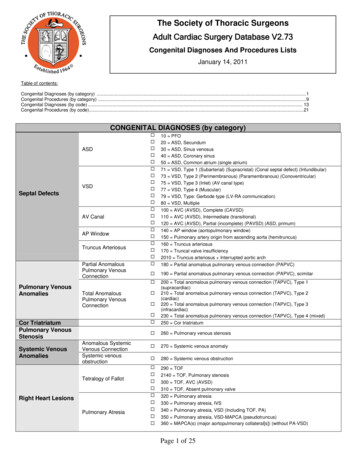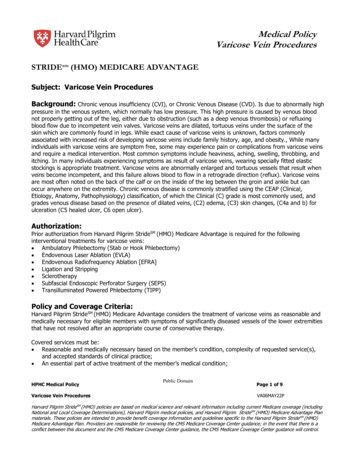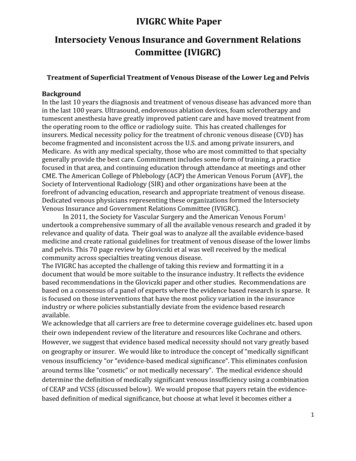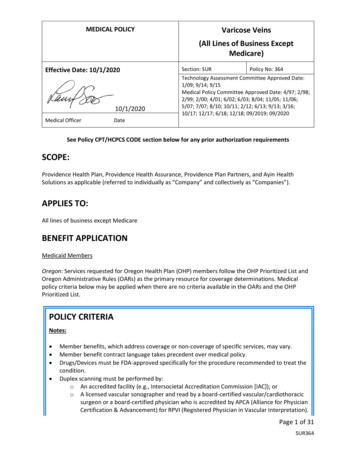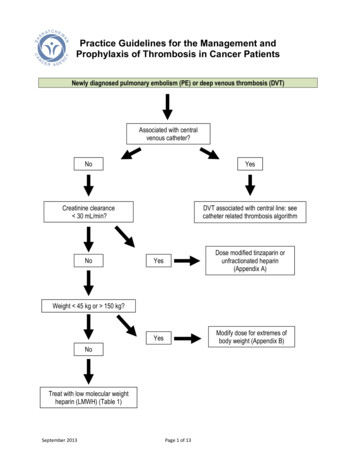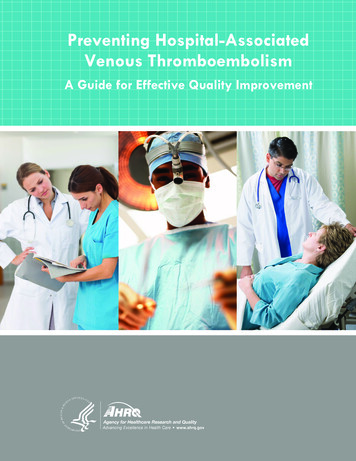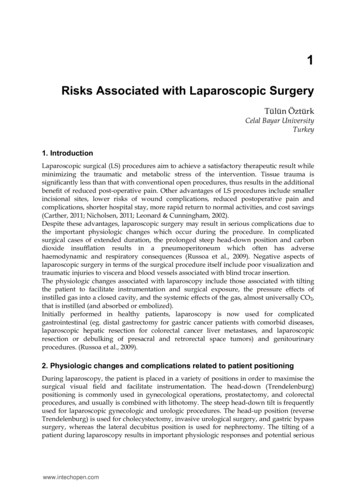
Transcription
clinical articleJ Neurosurg Spine 26:90–96, 2017Risk factors associated with venous thromboembolism inpatients undergoing spine surgeryKeaton Piper, BSc, Hanna Algattas, MD, Ian A. DeAndrea-Lazarus, BA,Kristopher T. Kimmell, MD, Yan Michael Li, MD, PhD, Kevin A. Walter, MD,Howard J. Silberstein, MD, and G. Edward Vates, MD, PhDDepartment of Neurosurgery, University of Rochester Medical Center, Rochester, New YorkObjective Patients undergoing spinal surgery are at risk for developing venous thromboembolism (VTE). The authors sought to identify risk factors for VTE in these patients.Methods The American College of Surgeons National Surgical Quality Improvement Project database for the years2006–2010 was reviewed for patients who had undergone spinal surgery according to their primary Current ProceduralTerminology code(s). Clinical factors were analyzed to identify associations with VTE.Results Patients who underwent spinal surgery (n 22,434) were identified. The rate of VTE in the cohort was 1.1%(pulmonary embolism 0.4%; deep vein thrombosis 0.8%). Multivariate binary logistic regression analysis revealed 13factors associated with VTE. Preoperative factors included dependent functional status, paraplegia, quadriplegia, disseminated cancer, inpatient status, hypertension, history of transient ischemic attack, sepsis, and African American race.Operative factors included surgery duration 4 hours, emergency presentation, and American Society of Anesthesiologists Class III–V, whereas postoperative sepsis was the only significant postoperative factor. A risk score was developedbased on the number of factors present in each patient. Patients with a score of 7 had a 100-fold increased risk ofdeveloping VTE over patients with a score of 0. The receiver-operating-characteristic curve of the risk score generatedan area under the curve of 0.756 (95% CI 0.726–0.787).Conclusions A risk score based on race, preoperative comorbidities, and operative characteristics of patients undergoing spinal surgery predicts the postoperative VTE rate. Many of these risks can be identified before surgery. Futureprotocols should focus on VTE prevention in patients who are predisposed to 656DKey Words venous thromboembolism; spine surgery; ACS NSQIP; quality; risk scoremore than a century of incremental progress in decreasing patient morbidity and death, therates of certain surgical complications remain highin specific patient populations.2,16,21 In addition to harmingthe patient, surgical complications add significant financial burden on the health care system.33 One prospectiveobservational study that analyzed spine surgery outcomesrevealed that even minor complications increased costs bymore than 8000 per patient, on average.46 Perioperativecare improvement offers substantial potential for reducinghealth care costs and preventing surgical complications.In 2006, the Centers for Medicare and Medicaid, in conespitejunction with organizations such as the Joint Commissionand the Leapfrog Group, implemented the Surgical CareImprovement Project to reduce surgical complicationrates. With hospital reimbursement now linked to surgicaloutcomes, hospitals have developed protocols for trackingand preventing surgical complications.23 One core goal ofthe Surgical Care Improvement Project is to combat thedevelopment of venous thromboembolism (VTE), including pulmonary embolism (PE) and deep venous thromboembolism (DVT). Although effective VTE chemoprophylaxis exists, the decision to medicate is complicatedby the associated increased risk of hemorrhage.5 To cre-Abbreviations ACS American College of Surgeons; ASA American Society of Anesthesiologists; AUC area under the curve; BMI body mass index; CPT Current Procedural Terminology; DVT deep venous thromboembolism; NSQIP National Surgical Quality Improvement Project; PE pulmonary embolism; SCR surgicalclinician reviewer; VTE venous thromboembolism.SUBMITTED January 10, 2016. ACCEPTED June 20, 2016.include when citing Published online September 2, 2016; DOI: 10.3171/2016.6.SPINE1656.90J Neurosurg Spine Volume 26 January 2017 AANS, 2017Unauthenticated Downloaded 07/24/22 05:08 AM UTC
VTE risk in patients undergoing spine surgeryate an evidence-based approach to VTE prophylaxis, therisk factors that predispose patients to the development ofVTE need to be explored further for each type of surgery.When planning neurosurgical procedures, knowing apatient’s VTE risk is of particular importance, becausechemoprophylaxis has been associated with intracranialhemorrhage and epidural hematoma, both of which canproduce irreversible, devastating neurological deficits.1,4,7,14Recent studies have shown that clinicians more commonlyavoid pharmacological prophylaxis out of fear of hemorrhage; yet, PEs have been shown to result in a mortalityrate higher than that of hemorrhages in patients undergoing neurosurgery.29,30,35 With this cautious avoidance ofiatrogenic hemorrhage, patients can be harmed by preventable PEs.It is difficult to understand the full magnitude of VTEcomplications in patients after spine surgery, becausestudies have revealed various rates for PEs and DVTs(from 0.3% to 31%).11,13,15,25,28,31,36,41 Variability in the datastems from limited sample sizes and different inclusioncriteria.38 The discrepancies in the data suggest that someof the cohorts might have had characteristics that predisposed them to VTE development. There have been severalstudies aimed at identifying these potential VTE risk factors, but they were also severely restricted by small samplesizes.4,10,31,42 The North American Spine Society’s recentliterature review on antithrombotic therapies for patientsundergoing spine surgery stated that there is insufficientevidence in the literature to make recommendations basedon the risks or benefits of VTE chemoprophylaxis.4There is currently no gold-standard algorithm for determining a patient’s risk of VTE development.6 A largecohort analysis aimed at identifying VTE risk factors inpatients undergoing spine surgery could clarify currentdiscrepancies in research and help to provide individualized recommendations regarding VTE chemoprophylaxisin patients undergoing spine surgery.4,39 To meet this need,large clinical databases have made massive expansionsover the past 20 years and can provide extensive details onperioperative characteristics of all surgeries performed inmany different hospitals across the United States.The purpose of this study was to analyze a large database to identify risk factors for VTE in patients undergoing spine surgery. Clinical factors were examined usinginformation found in the American College of Surgeons(ACS) National Surgical Quality Improvement Project(NSQIP) database (see www.facs.org/quality-programs/acs-nsqip).20 The NSQIP database records characteristics,operative factors, and postoperative complications of patients who underwent surgery. For this analysis, data fromthe years 2006–2010 were selected and examined. Riskfactors were identified and used to calculate a risk scorethat could be used in the future to predict a patient’s propensity to develop VTE.MethodsData CollectionAll patient data used in this analysis came from theACS-NSQIP data set. The NSQIP is an effort by the ACSaimed at the standardized collection of national surgi-cal data with a goal of improving the quality of healthcare. The ACS-NSQIP collects its data from a surgical clinician reviewer (SCR) at each associated hospital.The SCR is trained by the ACS-NSQIP organization, isaudited regularly, and maintains a degree of separationfrom the facilities’ surgeons.18 The SCR at each facilityrecords and reports preoperative to 30-day-postoperativedata on randomly assigned patients directly to the NSQIP.Additional materials describing training and auditingcan be found at the ACS-NSQIP website pecifics/data). Between 2006 and 2010, more than 200 hospitals reported to the NSQIP, and those data were analyzed in thisstudy.17,18,22,40Univariate AnalysisA total of 22,434 adult patients who underwent spinalsurgery between 2006 and 2010 were identified via theirprimary Current Procedural Terminology (CPT) code.Univariate 2-tailed chi-square analysis and the Fischer exact test, where appropriate, were used with nominal andordinal variables to identify clinical associations with theoccurrence of VTE.The following clinical factors from the ACS-NSQIPdata set were analyzed: sex; race; CPT code; inpatientstatus; transfer status; age; anesthesia used; level of resident supervision; height; weight; body mass index (BMI);history of diabetes; history of smoking; history of alcoholuse; history of dyspnea; do-not-resuscitate status; functional status prior to surgery; ventilator-dependent spinesurgery; history of esophageal varices; history of congestive heart failure; history of myocardial infarction; historyof percutaneous coronary intervention; history of angina;history of hypertension requiring medication; history ofperipheral vascular disease; history of limb pain at rest organgrene; history of renal failure; history of transient ischemic attack or stroke prior to surgery; history of bleeding disorder; history of chemotherapy or radiotherapy; history of systemic sepsis; pneumonia prior to surgery; ascites prior to surgery; on dialysis prior to surgery; impairedsensorium prior to surgery; hemiplegia, paraplegia, orquadriplegia prior to surgery; presence of a tumor involving the CNS; disseminated cancer prior to surgery; openwound or wound infection prior to surgery; steroid usefor a chronic disease at the time of spine surgery; greaterthan 10% weight loss prior to surgery; disseminated cancer prior to surgery; open wound or wound infection priorto surgery; blood transfusion of more than 4 units duringthe spine surgery; pregnant at time of surgery; surgery in30 days prior to the spine surgery; preoperative laboratoryvalues; surgeon who dictated the records; highest level oftraining of resident; emergency presentation; wound classification; American Society of Anesthesiologists (ASA)8physical status score; airway trauma during spine surgery;number of red blood cell transfusions during spine surgery; duration of anesthesia; duration of spine surgery andtotal operating room time; intraoperative complication;and a number of postoperative factors including wound infection, pneumonia, unplanned intubation, PE, prolongedventilation (greater than 48 hours), renal insufficiency orfailure, dehiscence, urinary tract infection, stroke, comaJ Neurosurg Spine Volume 26 January 201791Unauthenticated Downloaded 07/24/22 05:08 AM UTC
K. Piper et al.TABLE 1. VTE events and 30-day mortality ratesEventTotal No. of Patients (%)Mortality Rate (%)No VTEVTEDVTPEOverall cohort22,193 (98.9)241 (1.1)174 (0.8)91 (0.4)22,4340.44.14.63.30.5lasting longer than 24 hours, cardiac arrest requiring cardiopulmonary resuscitation, myocardial infarction, needfor blood transfusions, DVT, sepsis, septic shock, and return to the operating room.Univariate chi-square analysis was used to identify associations between VTE and clinical factors. The threshold for significance was set using an adjusted a value asdetermined by Holm-Bonferroni correction. Odds ratioswere computed when appropriate. Based on univariateanalysis, some categorical variables were converted tobinary variables (functional status dependent 1; ASAScore III–V 1; age 60 years 1; operating room time 4 hours 1; BMI 30 1). Binary variables were generated for these categories to calculate ORs and improve themultivariate regression model.Computation of VTE Risk ScoreWe used multivariate binary logistical regression (entrylevel 0.05, exit level 0.1) to analyze the clinical factors witha p value of 0.05 to determine variables independentlyassociated with VTE events. Preoperative and intraoperative variables were controlled when postoperative complications associated with VTE were independently subjectedto multivariate logistic regression. This analysis excludedpostoperative events in which the VTE occurred beforethe complication of interest. Covariate interactions wereidentified also with chi-square analysis, and these interactions were incorporated stepwise in iterations of multivariate regression; covariate interactions ultimately did notaffect the validity of the multivariate model. Analysis ofthe interactions between postoperative covariates yieldedpredictably significant interactions between postoperativecomplications but, similarly, did not affect the multivariate model. Goodness of fit of the multivariate regressionmodel was assessed using the Hosmer-Lemeshow test; p 0.05 indicates a model that fits the data appropriately.A total of 13 factors were identified as significant aftermultivariate regression and were included in the creationof a risk score. Each factor was converted to a binary variable so that the presence of each given factor was assigneda score of 1. Each independent risk factor was assigned1 point. The factors were used collectively to calculate apatient’s VTE risk score. Patients were assigned a totalscore for VTE risk, and scores ranged from 0 to 13 (median score 2). Because of the small number of patients witha score that exceeded 7, scores above that threshold weregrouped together. All patient VTE risk scores were entered into a receiver-operating-characteristic curve, whichyielded an area-under-the-curve (AUC) value to grade thepredictability of the model; AUC values greater than 0.70092TABLE 2. Factors associated with VTE incidence after univariateand multivariate analysis*FactorOR (95% CI)Operation time 4 hoursDependent functional statusParaplegiaEmergency presentationASA score IIISepsisDisseminated cancerInpatient statusHypertensionQuadriplegiaHistory of ischemic attackPostoperative sepsisAfrican American race3.59 (2.77–4.65)4.34 (3.20–5.89)3.74 (2.69–5.20)5.07 (3.32–7.75)2.73 (2.09–3.56)5.47 (3.52–8.50)6.83 (4.10–11.36)7.13 (3.17–16.05)2.08 (1.59–2.72)5.63 (3.02–10.48)2.95 (1.70–5.10)5.15 (2.69–9.86)2.11 (1.46–3.06)* All categories had a p value of 0.001.represent acceptable discrimination.19 SPSS 18.0 software(IBM) was used for all statistical analyses.ResultsThe rate of VTE in this cohort was 1.1%; specifically,0.4% were PE, and 0.8% were DVT. Of the 241 patientsin this cohort with VTE, 24 (10%) suffered from both PEand DVT. Both PE and DVT were statistically linked toa nearly 10-fold increase in the 30-day mortality rate forboth variables (Table 1).Univariate analysis revealed a number of preoperative,operative, and postoperative characteristics significantlyassociated with increased risk of developing VTE. Preoperative factors associated with VTE included dependentfunctional status, paraplegia, quadriplegia, disseminatedcancer, inpatient status, hypertension, history of ischemicattack, sepsis, African American race, presence of tumor,diabetes mellitus, dyspnea, and chemotherapy in the previous 30 days. Operative factors associated with VTEincluded surgery time 4 hours, emergent presentation,clean post–spine surgery wound, contaminated post–spinesurgery wound, and ASA Score III–V. Postoperative factors associated with the development of VTE includeddevelopment of infection, bleeding, sepsis, septic shock,urinary tract infection, and ventilator requirement (Tables2 and 3).Factors examined by univariate analysis were investigated further with multivariate binary regression analysis,which determined dependent functional status, paraplegia,quadriplegia, disseminated cancer, inpatient status, hypertension, history of ischemic attack, preoperative sepsis,African American race, surgery time 4 hours, emergentpresentation, ASA Score III–V, and postoperative development of sepsis to be independent statistically significantrisk factors (Table 2). The VTE risk score showed highpredictability of VTE, with incidence rates of 0.1% forthose with a score of 0 and 11.7% for those with a scoreof 7, and the distributions for PE and DVT were similar(Fig. 1). A higher VTE risk score also correlated with anJ Neurosurg Spine Volume 26 January 2017Unauthenticated Downloaded 07/24/22 05:08 AM UTC
VTE risk in patients undergoing spine surgeryTABLE 3. Factors associated with VTE incidence after univariateanalysis only*FactorOR (95% CI)Postop infectionPostop bleedingTumorPrevious op w/in 30 daysPostop septic shockContaminated woundClean woundDiabetes mellitusNeed for postop ventilatorDyspneaPostop UTIChemotherapy3.97 (2.61–6.06)3.22 (2.61–6.06)5.07 (3.02–8.52)3.36 (2.04–5.55)9.26 (3.97–21.64)2.41 (1.52–3.83)0.42 (0.26–0.66)1.90 (1.34–2.69)4.79 (2.33–9.86)0.51 (0.35–0.76)3.07 (1.71–5.54)6.89 (2.76–17.25)UTI urinary tract infection.* All categories had a p value of 0.001.increased mortality rate and increased average length ofstay (Table 4). The VTE risk score’s ability to predict VTEwas assessed by using a receiver-operating-characteristiccurve. The AUC was 0.757 (95% CI 0.727–0.788).DiscussionIn this analysis, we attempted to identify factors andfurther stratify patients according to their risk of VTEresulting from spine surgery. By analyzing preoperativecharacteristics that predispose patients to developingVTE, evidence-based decisions can be made for when touse chemoprophylaxis. In addition, measures can be takento attenuate these risk factors with the goal of diminishing VTE rates and associated health care costs in patientsundergoing spine surgery.The rise in administrative databases and clinical registries offers an avenue through which the previous limitations of small sample sizes and difficulties associated withperforming randomized controlled trials can be overcome.The ACS-NSQIP database was designed by clinicians andoffers the advantage of detailed clinically pertinent factorsthat contribute to surgical outcomes and complications.The NSQIP database has been shown by several studies toimprove surgical quality at local levels.17,18The NSQIP database has been used to examine riskfactors that affect VTE rates with general surgery,32,45breast surgery,43 vascular surgery,9,34,37 oncological surgery,27 urological procedures,44 and other neurosurgicalprocedures.23 These published studies helped to designthe methods of this study and minimize the confoundingvariables when comparing VTE rates among surgeries.Comparing our results, particularly the rates of DVT andPE, with those of previous studies is difficult because ofthe inconsistencies in previous measures of VTE in patients undergoing spine surgery. However, the rates calculated here are in line with the mean VTE rates fromlarger retrospective analyses (approximately 1%–3%).15,38These rates (VTE 1.1%, DVT 0.8%, and PE 0.4%) showthat spine surgery as a whole does not necessarily result inan increased incidence. This rate might be slightly underestimated, because the NSQIP reports only symptomaticVTEs. The major strengths of the NSQIP registry lie withthe extensive associated factors reported for all surgeriesthat were analyzed here.When comparing the findings, we identified similarfactors contributing to increased VTE risk, including ASAScore III, disseminated cancer, emergency presentation,preoperative sepsis, dependent functional status, and operation time 4 hours. Other factors that were significant inother studies and significant here in univariate analysis included the presence of tumor involving the CNS and needfor postoperative ventilator for 48 hours. Although thesefactors were significant in univariate analysis, they werenot deemed significant in our multivariate analysis. Otherfactors that have been linked to increased VTE risk withother surgeries but were not significant in this study included increased BMI, steroid use, postoperative pneumonia,and postoperative urinary tract infection.9,23,27,32,34,37,43,45 Itis interesting to note that a number of factors that were notidentified in other NSQIP analyses were identified here tobe associated with an increased risk of VTE, includingFig. 1. Rates of PE, DVT, and VTE grouped according to VTE risk score.J Neurosurg Spine Volume 26 January 201793Unauthenticated Downloaded 07/24/22 05:08 AM UTC
K. Piper et al.TABLE 4. VTE risk scores and ratesVTERiskScoreNo. ofPatients(% of e(%)*AverageHospitalLOS(days)*0123456 7Overall1702 (7.6)6026 (26.9)6087 (27.1)5096 (22.7)2419 (10.8)750 (3.3)243 (1.1)111 .71.22.34.19.511.70.5123461114184LOS length of stay.* All data in column are statistically significant.paraplegia, quadriplegia, inpatient status, hypertension,history of ischemic attack, and African American race.Although not identified by NSQIP analyses, these factors have been noted in other studies with different patientsettings as potential risks for VTE.3,12,13,24,26 For instance,Lee et al.24 performed a small multivariate analysis thatpredicted that hypertension is a risk factor for any complication in patients undergoing cervical spine surgery. Theresults of another study by Bell et al.,3 who analyzed 2large cohorts, suggested that African American race is arisk factor for VTE development. Folsom et al.12 proposedthat the increased rate of VTE development in AfricanAmerican patients might be because they have an increased prevalence of hemoglobin S. As for the VTE risklinked to paraplegia and quadriplegia, we can speculatethat the significance is a result of their association withtraumatic spine injury that requires surgery and the immobility of these patients.13,26 It is important to not classifythese as risk factors for VTE development unique to spinesurgeries without further investigation of them in othersurgical settings.Although the finding that these clinical factors are associated with VTE is not novel, we believe our development of a risk score demonstrates that these clinical factors are additive in their association with VTE, which isa novel finding. These results raise several questions thatmerit discussion and future research. Although spine surgery results in a low incidence of VTE development, certain characteristics predispose patients to VTE and canincrease their risks nearly 100-fold. Having simple methods for identifying these factors and thus preventing surgical complications are particularly important now with theshift away from fee-for-service toward quality-based reimbursement models. Most of the factors identified here arepatient characteristics that are identifiable before surgery,which is important because surgical management can beadjusted to reduce complications based on the patient’sVTE risk. The VTE risk score presented here provides asimple means for clinicians to calculate patient VTE riskat the bedside and can aid in making an evidence-basedjudgment on when to use chemoprophylaxis.94The VTE risk score shows a clear correlation betweenincreased rate of VTE and each additional VTE risk factoridentified here (Table 4). A value of 1 was assigned to eachrisk factor in hopes of making calculation of the risk scoremore applicable to clinicians at the bedside with time constraints. The risk-score trend shown in Fig. 1 shows thatthe nonweighted risk score generated here still predictsVTE development. There is great utility in the simplicityof this calculation for clinical use. Still, further researchshould be directed toward exploring the pathogenesis andsignificance of each risk factor. By better understandingeach risk factor, a weighted VTE risk-score calculatorcould be developed to provide a more accurate determination of VTE development based on which unique riskfactors each patient has. Of the 13 significant VTE riskfactors, only 1 factor was postoperative. With the majority of the factors identifiable before surgery, the VTE riskscore shows great promise for preventing VTE development through bedside applications. By studying these 13VTE risk factors specifically in patients undergoing spinesurgery, research efforts can be focused on reducing thedevelopment of VTE.This study has several limitations. Any retrospectiveanalysis has a potential for error due to selection bias;however, the ACS-NSQIP attempted to reduce selectionbias by expanding the number of hospitals that participate in the database. Although the breadth of the databasehas benefits, it also raises concerns regarding the qualityand reliability of the data because of potentially different interpretations of the parameters for reportable events.This concern is minimized by the demanding data-quality requirements that have affected the quality of surgical care in other studies.17 The NSQIP set the standardfor DVT to mean that a clot demands anticoagulation orvena cava filter placement in addition to diagnosis by duplex ultrasound, venography, or computed tomographyof a thrombosis occurring along a vein.20 As for PE, theNSQIP requires that the diagnosis be made by either ahighly probable ventilation–perfusion scan or definitivelywith another imaging modality.20 The strict requirementscan still contribute to selection bias, because only hospitals with certain resources, predominantly large academicinstitutions and research facilities, contribute to the ACSNSQIP data set. Another limitation of the ACS-NSQIPdatabase is that the method of VTE prophylaxis is not reported to the database. Patients with known VTE risk factors might have been offered a prophylactic measure thatprevented a VTE, and therefore, important risk factorsmight not have been fully evident in our study. However,our study still identified 13 risk factors that might be lessobvious and still significant, because the lack of reportingVTE prophylaxis is more likely to result in the underestimation of a risk factor than overestimation.It is obvious that analysis based on a data set is limitedby the data collected. A limitation of our study resides indetails about each PE and DVT that occurred in these patients, because the ACS-NSQIP data set does not provideinformation on the location of the VTE. Additional relevant data lacking in the ACS-NSQIP database would beinformation regarding the use of chemoprophylaxis andresulting hemorrhagic complications. Another limitationJ Neurosurg Spine Volume 26 January 2017Unauthenticated Downloaded 07/24/22 05:08 AM UTC
VTE risk in patients undergoing spine surgeryof our model is that it has not been validated. Future investigations should aim to validate the utility of this VTErisk score in predicting VTE in other neurosurgical cohorts and assessing other factors intrinsic to the surgery,such as surgical approach, that can be added to the score.Validation of this study might be achieved through repeating this risk-factor analysis with data from other nationaldatabases and with newer data to compare the significantrisk factors. In addition, a prospective study analyzingvarious VTE-prophylaxis strategies in patients thought tobe at high risk for VTE based on the score presented herewould be a reasonable next step for further validation.ConclusionsAlthough the rate of VTE incidence in patients undergoing spinal surgery is low, the potential for severe complications from clotting and hemorrhaging that lead toepidural hematoma raises concern for identifying patientsat high risk for VTE development. A number of patientand operative characteristics have been linked to increasedrisk of VTE. The VTE risk score presented here found 13unique factors that increase a patient’s risk of developing aPE or DVT. Additional studies should aim to validate thisscore and inspect the clinical benefits of VTE prophylaxisin patients at high risk.References1. Agnelli G: Prevention of venous thromboembolism in surgical patients. Circulation 110 (24 Suppl 1):IV4–IV12, 20042. Anderson FA Jr, Zayaruzny M, Heit JA, Fidan D, Cohen AT:Estimated annual numbers of US acute-care hospital patientsat risk for venous thromboembolism. Am J Hematol 82:777–782, 20073. Bell EJ, Lutsey PL, Basu S, Cushman M, Heckbert SR,Lloyd-Jones DM, et al: Lifetime risk of venous thromboembolism in two cohort studies. Am J Med 129:339.e19–339.e26, 20164. Bono CM, Watters WC III, Heggeness MH, Resnick DK,Shaffer WO, Baisden J, et al: An evidence-based clinicalguideline for the use of antithrombotic therapies in spine surgery. Spine J 9:1046–1051, 20095. Buesing KL, Mullapudi B, Flowers KA: Deep venous thrombosis and venous thromboembolism prophylaxis. Surg ClinNorth Am 95:285–300, 20156. Camden R, Ludwig S: Prophylaxis against venous thromboembolism in hospitalized medically ill patients: Update andpractical approach. Am J Health Syst Pharm 71:909–917,20147. Cote LP, Greenberg S, Caprini JA, Stone J, Arcelus JI,López-Jiménez L, et al: Outcomes in neurosurgical patientswho develop venous thromboembolism: a review of the RIETE registry. Clin Appl Thromb Hemost 20:772–778, 20148. Davenport DL, Xenos ES: Deep venous thrombosis afterrepair of nonruptured abdominal aneurysm. J Vasc Surg57:678–683, 683.e1, 20139. Dripps RD: New classification of physical status. Anesthesiology 24:111, 196310. Eskildsen SMMS, Moll S, Lim MR: An algorithmic approach to venous thromboembolism prophylaxis in spinesurgery. J Spinal Disord Tech 28:275–281, 201511. Fang MC, Maselli J, Lurie JD, Lindenauer PK, Pekow PS,Auerbach AD: Use and outcomes of venous thromboembolism prophylaxis after spinal fusion surgery. J Thromb Haemost 9:1318–1325, 201112. Folsom AR, Tang W, Roetker NS, Kshirsagar AV, DerebailVK, Lutsey PL, et al: Prospective study of sickle cell traitand venous thromboembolism incidence. J Thromb Haemost 13:2–9, 201513. Giorgi Pierfranceschi M, Donadini MP, Dentali F, Ageno W,Marazzi M, Bocchi R, et al: The short- and long-term riskof venous thromboembolism in patients with acute spinalcord injury: a prospective cohort study. Thromb Haemos
2006-2010 was reviewed for patients who had undergone spinal surgery according to their primary Current Procedural Terminology code(s). Clinical factors were analyzed to identify associations with VTE. reSUltS (pulmonary embolism 0.4%; deep vein thrombosis 0.8%). Multivariate binary logistic regression analysis revealed 13
